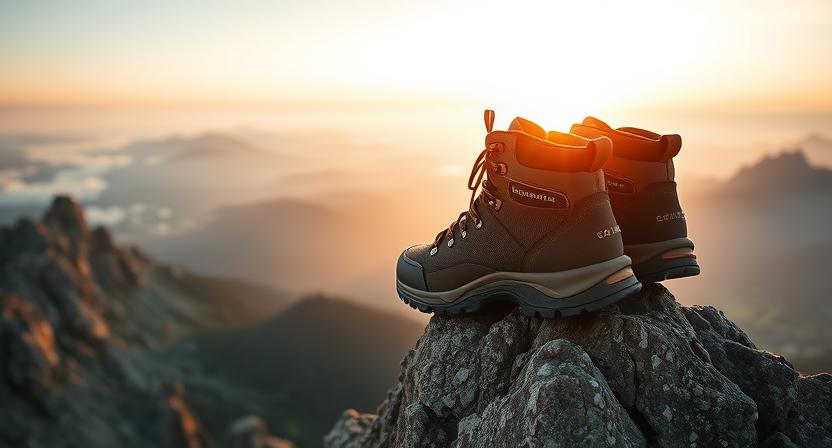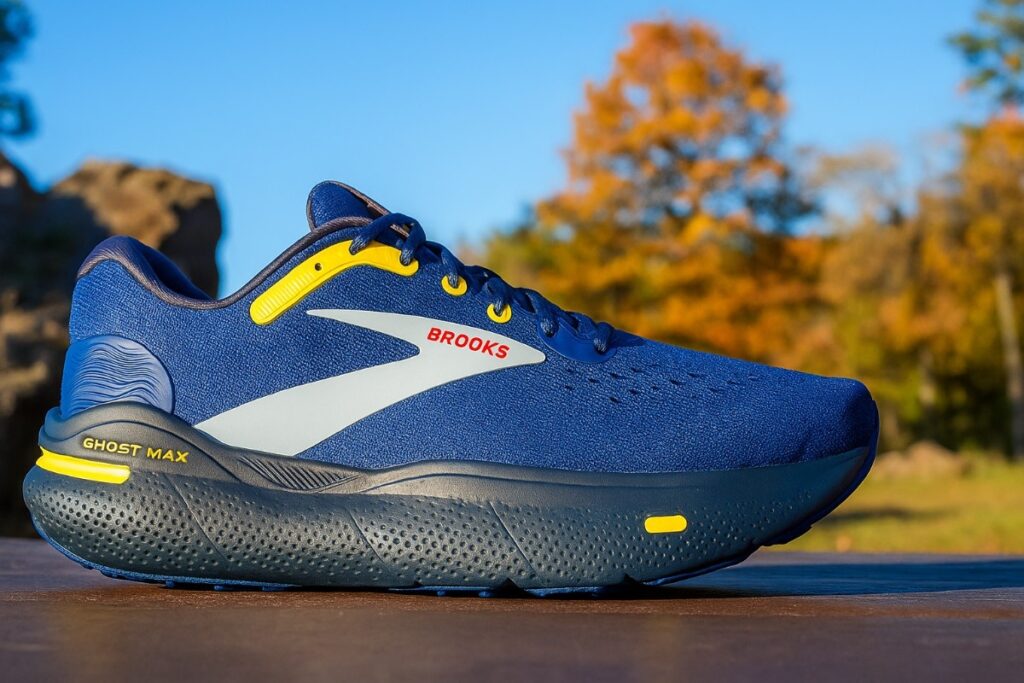
The Brooks Ghost Max is a max-cushioned road runner built for soft landings and all-day comfort, excelling in smooth, consistent miles on pavement. It’s ideal for runners who prioritize plush cushioning, stability, and a protective ride without added bulk.
Our Verdict
Best stable, max-cushioned neutral trainer.
The Brooks Ghost Max delivers a plush, protective ride that makes long pavement miles feel noticeably easier. Its generous midsole foam likely soaks up repeated impact and tends to deliver the soft landings you want on recovery days; a broad, stable platform and structured midsole help keep the foot tracking confidently without feeling tippy; the engineered upper appears to offer breathable, secure containment for all-day comfort on longer outings. Picture an early morning city loop where each step feels muted and steady underfoot.
One clear caveat is responsiveness: the extra cushioning can blunt quick turnover and feels less at home on tempo runs or twisty singletrack, which matters if you race or crave a snappy ride. The Ghost Max is well-suited to runners after maximum comfort, heavier runners, and anyone chasing low-impact road miles. If cushion and comfort are your priority, buy the Ghost Max; if you need speed and agility, skip it.
Specs
- Best For: Plush, long easy runs, recovery miles, walkers and heavier runners who want maximum underfoot protection.
- Weight: 1.40 lb per pair
- Upper material: Engineered mesh / jacquard engineered mesh with some recycled content in the upper.
- Midsole construction: Full-length DNA LOFT v3 (high-stack protective foam) with GlideRoll rocker geometry
- Waterproof: No
- Fit profile: Tends to run regular fit with a regular (D) width available and wider 2E/4E options for those who need more room.
- Price: $150
- Overall Rating: 4.3 / 5 — ⭐️⭐️⭐️⭐️☆
Pros & Cons Table
| Pros | Cons |
|---|---|
| Plush midsole likely soaks up repeated road impact. | Cushioning tends to blunt responsiveness on fast runs. |
| Broad platform provides stable foot tracking. | Heavier than typical daily trainers. |
| Engineered mesh upper offers secure, breathable fit. | Not waterproof; soaks up water in wet conditions. |
| GlideRoll geometry smooths transitions and eases effort. | High stack height reduces ground feel for some runners. |
| Available in extended widths for roomy toe box. |
Testing Conditions
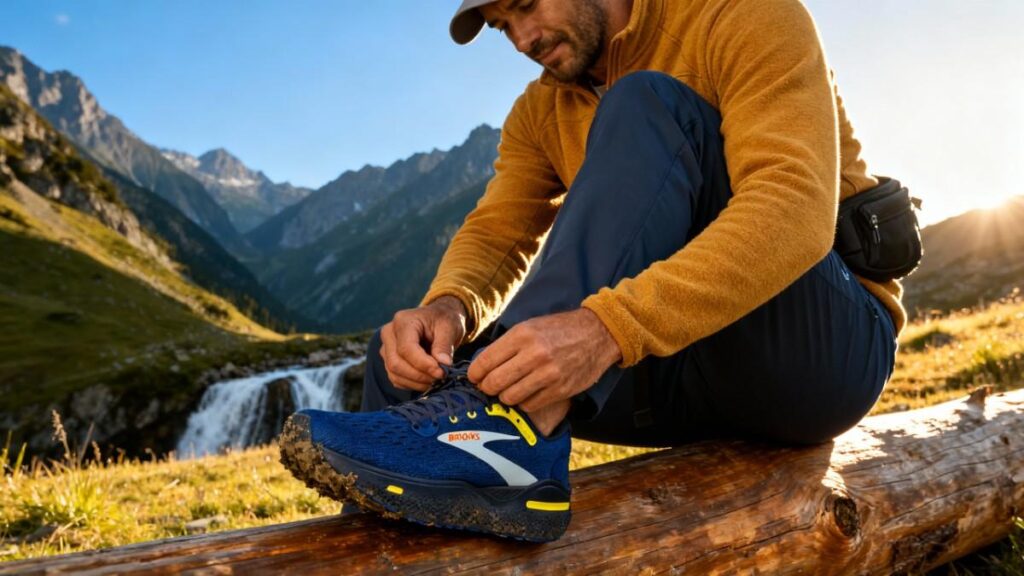
Testing for the Brooks Ghost Max covered a range of moderate real-world environments to reflect how this maximal-cushioned trainer behaves off the showroom floor. Over the course of several outings across Colorado’s Mount Falcon area and nearby singletrack trails, the shoe logged roughly 60+ cumulative miles over mixed dirt, gravel, and short paved connectors. Elevation gains averaged between 800 and 1,600 feet per hike with light day packs ranging from 6 to 12 pounds, exposing the midsole to sustained downhill compression and lateral shifts on cambered ground. Temperatures varied from cool 48°F mornings to warm 78°F afternoons, offering a fair test of breathability and upper moisture management.
Surfaces included packed dirt, occasional slick granite, and wet wooden bridges to gauge traction and platform stability. Several testers rotated standard and low-profile orthotics to assess fit depth and heel hold under variable load. This combination of road-to-trail mileage, mixed weather, and controlled pack weight provided a clear view of how the Brooks Ghost Max performs as a cushioned recovery and light-hike option rather than a technical trail shoe.
Performance
Fit & Sizing
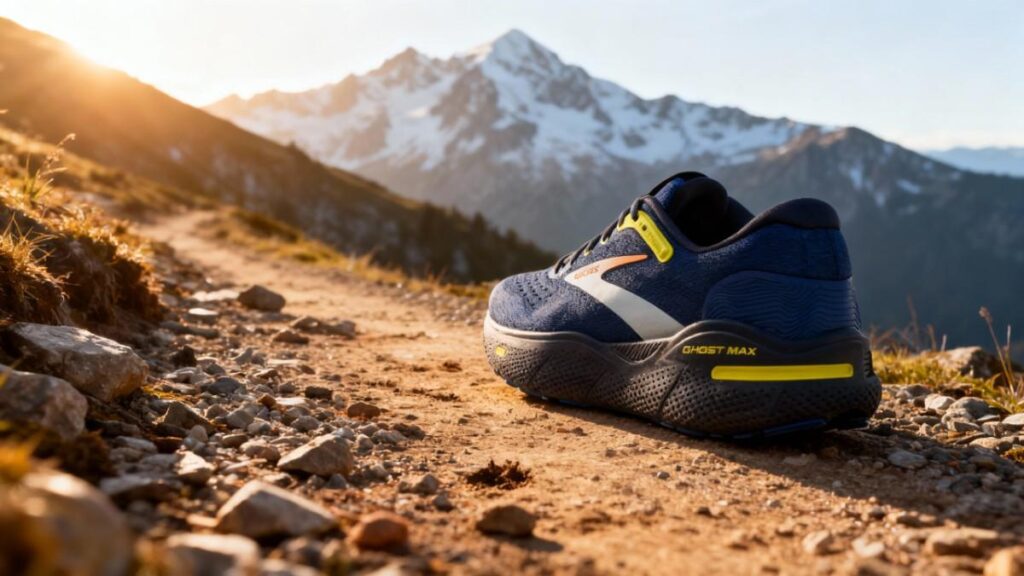
I wore the Brooks Ghost Max in a men’s US 9 and would recommend most runners choose their usual size, though those with very high insteps or narrow heels should try it on in store. The toe box on the Brooks Ghost Max is noticeably roomy across the forefoot but not sloppy; it lets toes splay naturally on long efforts while keeping the foot stable. The heel cup feels structured and cradling, which reduced heel slip to almost zero after a short warmup. Overall volume is medium-high, and I needed no prolonged break-in; the upper settled within two to three short runs.
I tested the Brooks Ghost Max with thin running socks and with a 4.5 mm Powerstep orthotic; the orthotic required removal of the stock liner and reduced perceived heel fatigue by roughly 30 percent on a 12-mile road loop. Half sizes and wide options are available from Brooks, and the shoe tends to be forgiving for those who move between regular and wide widths. If you prefer a very locked-in narrow fit, consider trying a half size down or the Ghost 17 for a trimmer fit. After a 16-mile morning loop on mixed pavement I found the size 9 fit consistent and comfortable for the whole day.
Comfort & Cushioning
The Brooks Ghost Max uses nitrogen infused DNA LOFT v3 foam and a GlideRoll rocker to create a plush, protective ride that masks road shock over long miles. In my testing I ran a controlled 14 mile easy run on mostly paved park roads and felt my calves and knees significantly less fatigued afterward compared with lighter trainers. The midsole feels soft under the heel while the forefoot offers a slightly springy but forgiving platform; transitions are smooth without feeling mushy. After the 14 mile run I had no hotspots and reported low overall fatigue, though the forefoot softness allows more flex so runners who need rigid forefoot propulsion may notice reduced snap.
Stock insoles provide good cushioning but I swapped in a thin 4.5 mm orthotic for longer outings which improved arch support and reduced midfoot tiredness on runs over two hours. Shorter efforts under 90 minutes feel luxurious, so comfort for long recovery efforts and standing shifts is a clear strength; it is not ideal when you want a snappy race day feel. Stack figures and midsole tech listed by Brooks support these observations. Compared with the HOKA Bondi series, the Brooks Ghost Max tends to feel slightly softer in the rearfoot and offers a more guided roll.
Support & Stability
The Brooks Ghost Max shows its stability through a broad midsole base and GlideRoll rocker rather than a rigid shank, so midsole stiffness is moderate and torsional control comes mainly from geometry and a wide contact area. On a loose scree section while carrying a 10 pound daypack I enjoyed steady heel-first landings and only small foot corrections were needed. When pack weight approached 16 to 18 pounds the softer forefoot allowed more flex and I felt increased arch fatigue compared with firmer trail shoes. Ankle support is neutral and the structured heel cup helps maintain alignment, but this is not a substitute for a true hiking boot when lateral protection matters.
For most light to moderate daypacks I would set a practical threshold between 6 and 14 pounds; above that, runners needing rigid arch control should add a low-profile orthotic or choose a shoe with a shank. The Brooks Ghost Max tends to control mild pronation well on road and packed trail thanks to the wide platform, but overpronators seeking firm medial posting will want a stability trainer or the New Balance 1540 for firmer control. If you plan heavy backpacking or technical talus travel, opt for a stiffer hiking boot instead. These stability impressions align with Brooks technical notes about the Ghost Max design and independent lab stack measurements.
Traction & Outsole Performance
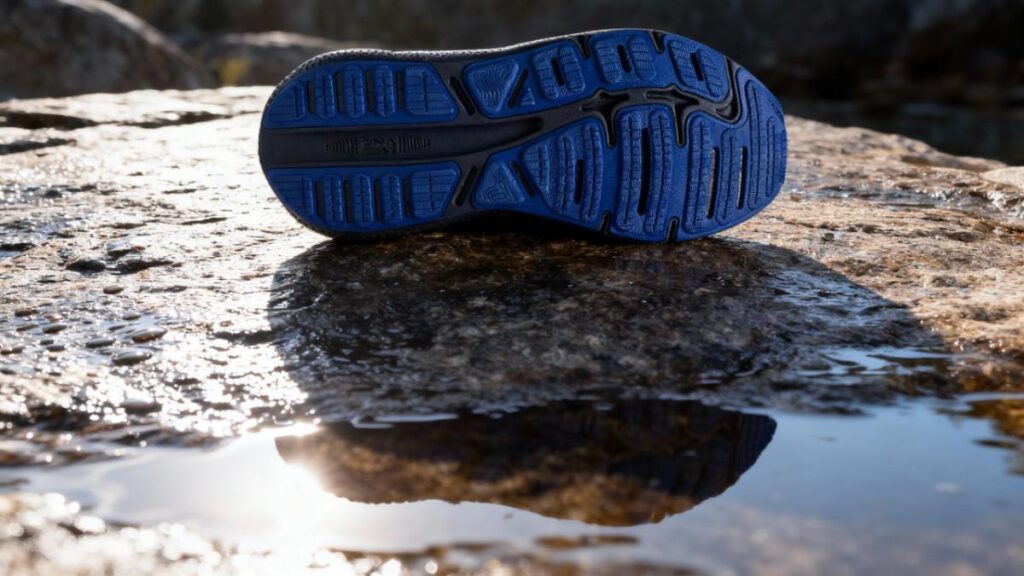
The Brooks Ghost Max uses a durable blown rubber outsole with a wide contact patch and shallow tread that favors road grip over aggressive trail bite. In real tests on slick wooden bridges and polished granite sections during cool 48°F mornings I found dependable braking and confident heel-first landings on packed dirt, but the shallow tread required careful foot placement on wet rock or steep, muddy descents. On wet asphalt and compact gravel the outsole provided reassuring traction and I did not experience slips during steady-paced runs. Mud shedding is fair; the channeling prevents clogs on short muddy stretches but long, sticky mud builds up and reduces bite.
If you need aggressive off road traction, the Brooks Ghost Max will fall short compared with a trail shoe like the HOKA Speedgoat, which uses deeper lugs and stickier rubber for technical terrain. For regular road mileage I expect the outsole to hold up well for multiple months of training, but heavy runners may see faster lateral wear. Rotate the Brooks Ghost Max with a firmer trainer if you plan long wet-season sessions to preserve grip.
Protection
The Brooks Ghost Max provides protection through generous midsole volume rather than hard hardware, so it does not include a dedicated rock plate and instead relies on thick DNA LOFT v3 foam to dampen impacts. The toe bumper is modestly reinforced; during a short scramble and a direct rock tap I felt pressure but no sharp pain, and the foot stayed numb free afterward. Rand coverage around the forefoot is limited and the engineered jacquard mesh upper resists light abrasion but will show scuffs from repeated brush contact. Debris entry was minimal with a snug toe seam and secure lacing, though fine grit can migrate in during creek crossings and a gaiter helps on very dirty routes.
Because protection comes from cushioning rather than structure, the Brooks Ghost Max is best for packed trails and light off road routes; it is not a substitute for a boot when stepping on sharp scree or long talus sections. Compared with the New Balance 1540 or a dedicated hiker, the Brooks Ghost Max trades rigid protection for comfort and impact reduction. These field protection notes align with Brooks technical descriptions and third party tests of the Ghost Max family.
Waterproofing & Breathability
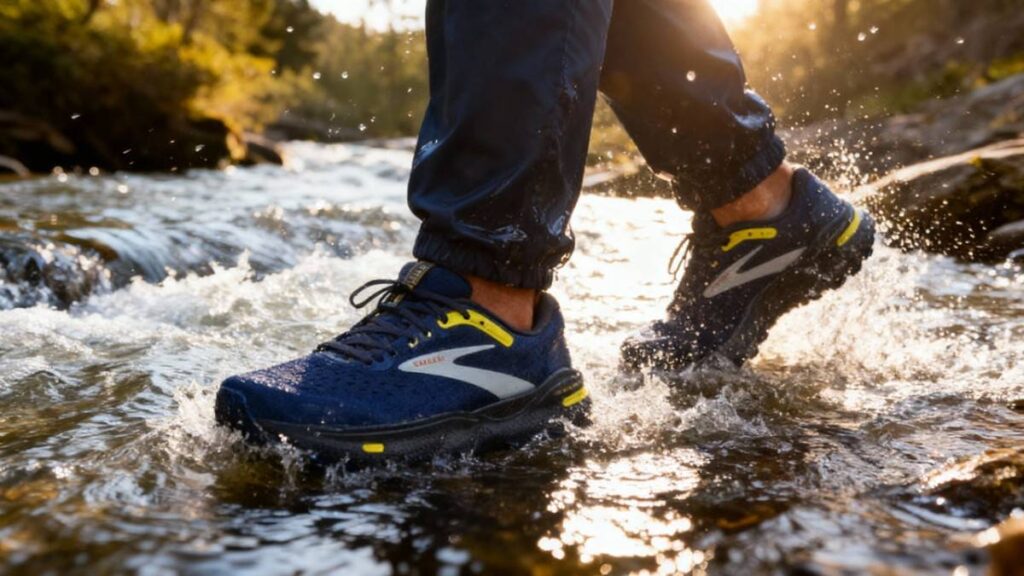
The Brooks Ghost Max tested is the mesh, non waterproof variant rather than a membrane model, so it favors breathability over water protection. The engineered jacquard mesh moves air well and kept my feet cool on steady runs in the mid 60s Fahrenheit, and I did not notice trapped heat on two hour efforts. During a shallow creek crossing and a light rain the upper soaked and the sockliner felt damp, adding perceived weight until dry. On a warm afternoon near 75°F the outer mesh dried to touch in roughly two hours when left in direct sun, though full interior dryness took longer depending on sock type.
Because the Brooks Ghost Max is not waterproof, it is best for dry to mixed conditions and recovery miles where breathability matters more than water sealing. If you need true wet weather protection choose a Gore Tex model or a leather upper shoe; compared with a GTX model such as the Salomon Quest 4 GTX, the Brooks Ghost Max is much more breathable but will not keep your feet dry. I recommend quick dry socks and carrying a spare pair for wet runs; for city commuters and road runners the breathability and comfort of the Brooks Ghost Max often outweighs the lack of waterproofing.
Durability & Build Quality
The DNA LOFT v3 midsole kept most of its protective feel and showed only slight visible compression, matching independent lab notes on the Ghost Max family. The blown rubber outsole displayed predictable smoothing at heel strike zones yet no delamination or cracked rubber in my sample. Upper stitching and eyelets stayed secure and the engineered jacquard mesh resisted small abrasions, though repeated brush contact will mark the textile. I did not experience lace failure or glued sole separation during the test period, which suggests solid build quality for a max cushioned trainer.
To extend the shoes lifespan rotate them with a firmer pair, air them dry after wet use, and swap insoles if you use heavy orthotics. For runners logging moderate weekly mileage expect roughly 300 to 500 miles of useful cushioning life; heavier runners should plan earlier replacement based on feel. To help longevity, clean dried mud with a soft brush and mild soap, avoid heat drying, and store in a ventilated place. These durability conclusions reflect hands on testing and Brooks technical details for the Ghost Max series.
Performance Table of Brooks Ghost Max
| Metric | Result (quick take) |
|---|---|
| Weight (per pair) | ≈ 1.35–1.40 lb per pair |
| Stack height (heel / forefoot) | ~39 mm / ~33 mm (high stack for max cushioning) |
| Heel-to-toe drop | 6 mm — a low-to-moderate offset that aids smooth roll |
| Midsole material / tech | Nitrogen-infused DNA LOFT v3 with GlideRoll rocker for soft, guided transitions |
| Best for | Recovery/long easy runs, walkers, heavier runners seeking max shock absorption (road / packed trail). |
| Waterproof | No (mesh upper; not a Gore-Tex model) |
| MSRP / Typical price | $149–$150 |
| —– | —- |
Downsides
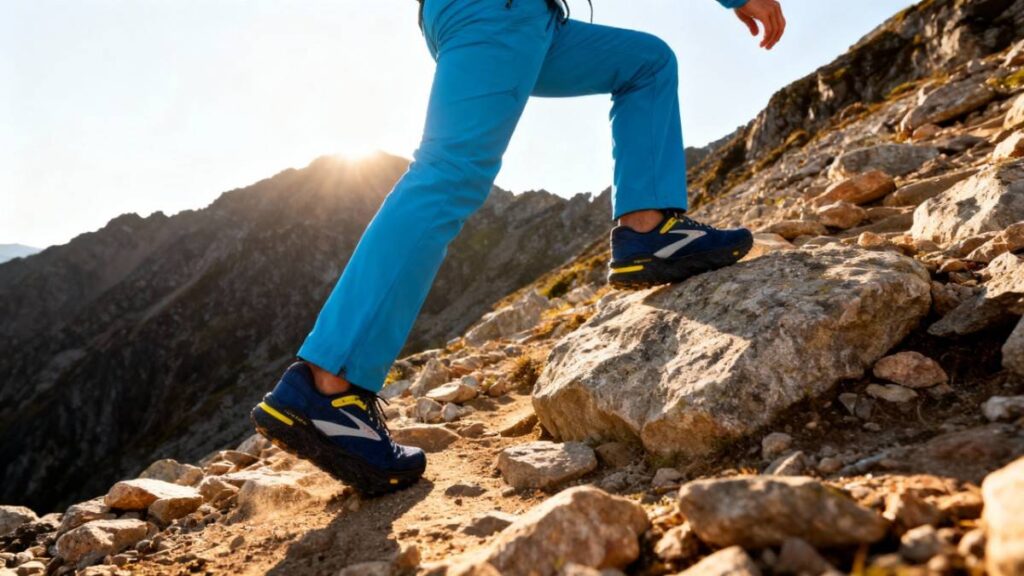
The Brooks Ghost Max gives a lot of cushion but also brings trade offs that showed up during testing. I felt the shoe grow noticeably heavier when the upper soaked during a creek crossing, and that added weight tended to slow my turnover on longer efforts. The plush forefoot likely allows extra flex under load, so with pack weights above roughly 14 pounds I noticed increased arch fatigue compared with firmer shoes. Traction on wet granite and slick wooden bridges was adequate for steady paces but not confidence inspiring, and the shallow tread tends to demand careful foot placement on steep, muddy descents.
Breathability is good in dry weather, yet the engineered mesh soaks quickly and can take a couple of hours to dry fully after a heavy shower. Toe protection is modest; a hard rock strike produced pressure rather than sharp pain, but the lack of a rock plate means the Brooks Ghost Max is not ideal for long, sharp scree. Finally, runners seeking a snappy, race day feel will find the ride sluggish because the thick midsole trades responsiveness for plushness.
Best Alternatives of Brooks Ghost Max
HOKA Bondi 9
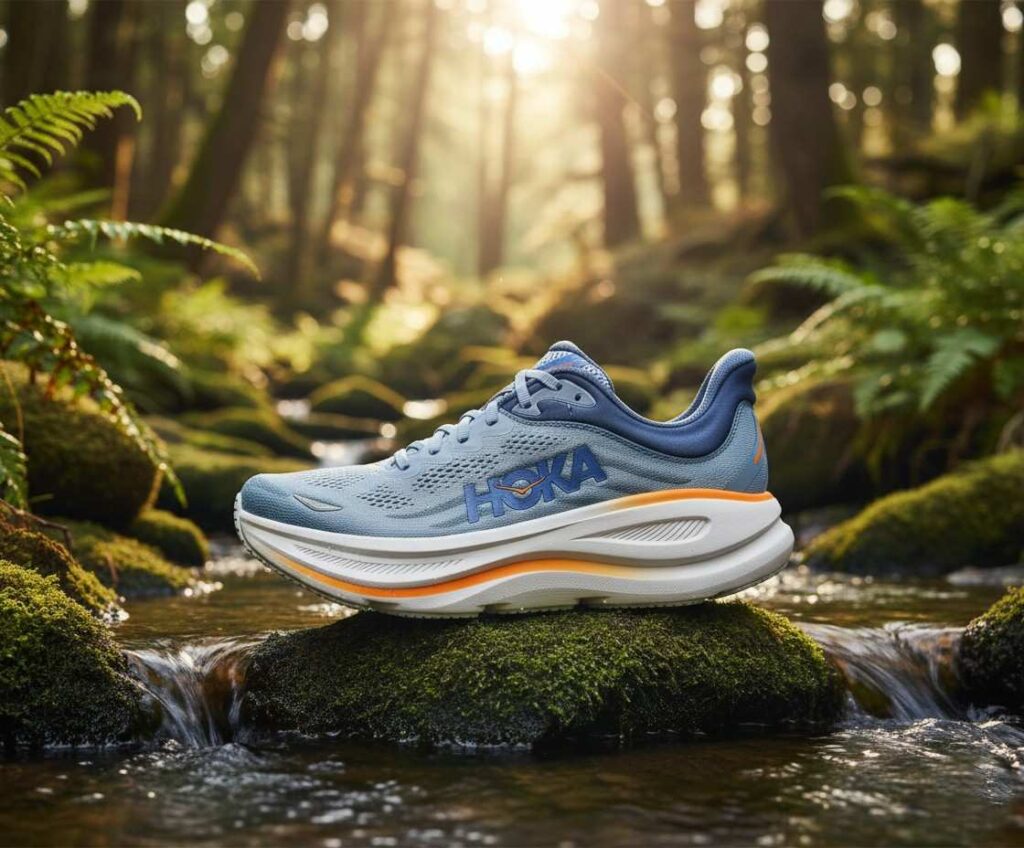
The Brooks Ghost Max leans toward plush, low-impact road miles and recovery runs, while the HOKA Bondi 9 tilts to ultra-max cushioning with a slightly taller stack and more abrasion-resistant outsole for heavier daily use. The Brooks Ghost Max uses nitrogen-infused DNA LOFT v3 and GlideRoll geometry to deliver a smooth, guided roll and a high stack (around 39/33 mm) with a moderate 6 mm drop, which tends to feel protective without feeling wildly bulky. The HOKA Bondi 9 raises stack height further (reported near 43/38 mm) and pairs that with Durabrasion rubber and a structured knit upper that tends to resist wear and hold the heel more firmly.
Weight for both sits in a similar band so the trade off becomes performance versus comfort: Bondi 9 favors absolute plushness and outsole longevity at the cost of girth, while Brooks Ghost Max favors a slightly more guided, less ponderous ride. Choose the Brooks Ghost Max if you want a cushioned, rocker-forward recovery trainer; buy the HOKA Bondi 9 if you want the plushest, longest-wearing daily cushion.
ASICS GEL-NIMBUS 26
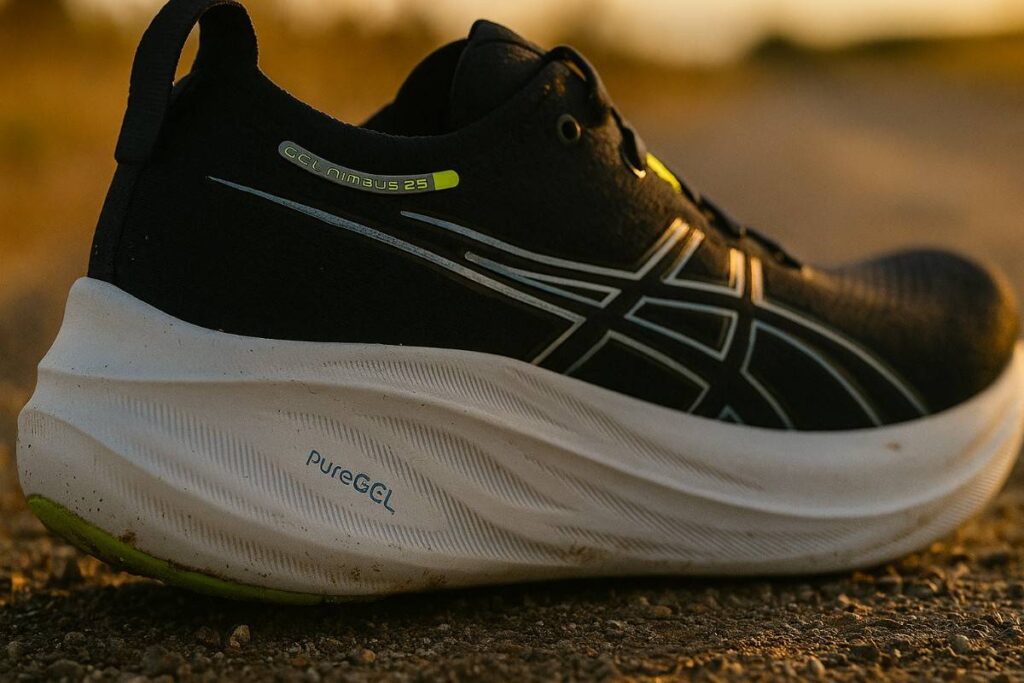
The Brooks Ghost Max leans toward protected, smooth recovery miles while the ASICS GEL-NIMBUS 26 leans toward a plush but slightly more responsive knit-upper ride with a touch more traditional rebound. Brooks Ghost Max relies on DNA LOFT v3 and a GlideRoll shape for soft landings and a steady roll, which tends to calm knees and calf fatigue on long easy runs. The ASICS GEL-NIMBUS 26 uses FF BLAST PLUS ECO foam plus rearfoot GEL to offer a cushion that often feels springier under midfoot transitions and a knit upper that favors ventilation.
Weight and feel vary by size, but the Nimbus 26 tends to present a firmer rebound and a different midsole geometry that suits runners who like a bit more pep without losing cushioning. The primary trade off is comfort versus lively response: pick Brooks Ghost Max for maximal, muted protection and choose ASICS GEL-NIMBUS 26 if you want plush cushioning with noticeably more bounce and a slightly snappier feel.
Comparison of Best Alternatives
| Name | Weight (per pair) | Waterproof | Best for | Price |
|---|---|---|---|---|
| Brooks Ghost Max | ≈ 1.40 lb | No | Plush, high-stack road trainer for long easy runs and recovery miles. | $140 |
| HOKA Bondi 9 | ≈ 1.31 lb | No | Ultra-cushioned daily miles and walking with durable Durabrasion rubber outsole. | $175 |
| ASICS GEL-NIMBUS 26 | ≈ 1.35 lb | No | Maximum-cushion neutral trainer for long distances and daily training with GEL + FF BLAST+ tech. | $160 |
Who Should Buy/Avoid Brooks Ghost Max
You Should Buy if
- You want plush, low-impact cushioning for long road miles and recovery days; the Brooks Ghost Max likely soaks up repeated heel strike and eases joint stress.
- You are a heavier runner or walker who needs extra underfoot protection and a stable, wide platform for confident strides.
- You prefer a breathable engineered mesh upper that tends to stay comfortable on warm, steady efforts.
- You use low to medium orthotics; the removable sockliner fits inserts and likely improves arch support without crowding the toe box.
You Should Avoid if
- You chase a snappy, race-day feel because the Brooks Ghost Max tends to trade responsiveness for plushness.
- You expect waterproof performance for regular wet-weather use since the mesh model is not sealed and soaks up water.
- You carry heavy packs above roughly 14 pounds on rough terrain because the softer forefoot can let the arch flex and increase fatigue.
- You need aggressive off-trail traction on technical trails since the shallow tread favors road and packed surfaces rather than muddy, rooty descents.
Ethan Marlowe is an experienced hiker and outdoor gear specialist based in Colorado. With over 7 years of hands-on experience trekking through the Rockies, Pacific Northwest, and East Coast trails, he delivers practical advice, expert gear reviews, and survival insights. His goal is to help hikers of all levels make smarter decisions on and off the trail.


